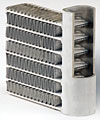
Components are joined together into a single coil using aluminum-zinc alloy brazing materials in a nitrogen-charged brazing furnace. (Photo courtesy of Heatcraft Refrigeration Products.)
[Editor’s note: In recent years, coil technology has increasingly focused on microchannel. This advanced approach offers a way to improve thermal performance, reduce refrigerant charge, and improve corrosion resistance. The application of this technology originated in the auto industry more than 20 years ago. Parallel-flow aluminum tubes are brazed to aluminum fins. This is different from two other common approaches: using copper tubes with aluminum fins, or aluminum tubes with spiny fins wrapped around them. This article details microchannel technology and was prepared for use inThe NEWSby Heatcraft Refrigeration Products, which recently introduced its proprietary HyperCore™ microchannel coil technology into its 1/2- to 6-hp air-cooled condensing unit product line.]
Microchannel condenser coils are all aluminum coils with multiple flat tubes containing small channels (microchannels) through which refrigerant flows. Heat transfer is maximized by the insertion of angled and louvered fins in-between the flat tubes.
The coil is composed of three components:
1.A flat microchannel tube.
2.Fins located between the microchannel tubes.
3.Two refrigerant manifolds.
These components are joined with two refrigerant manifolds using an aluminum-zinc alloy brazing material in a nitrogen-charged braze furnace to make the completed microchannel coil. Coil circuiting is accomplished by placing baffles in the distribution manifolds to feed the refrigerant through the flat tubes.
•Thermal performance:The higher heat transfer performance is obtained by the flat tubes, which maximize airside heat transfer, and microchannels within the tubes. The microchannels maximize refrigerant side heat transfer via multiple tiny refrigerant channels which provide increased primary surface area. Additionally, the metallurgical fin-tube bond resulting from the braze operation maximizes surface contact and increases the heat transfer surface area, further improving the heat transfer performance of the coil.
•Corrosion protection:The corrosion potential with the all aluminum microchannel coil is significantly lower than in copper/aluminum (bi-metal) RTPF coils as there are no dissimilar metals to initiate galvanic corrosion. This makes microchannel coils an inherently better solution for coastal installations, or any application where corrosion may be a concern.
•Refrigerant charge:Microchannel coils have a smaller volume, lowering condenser refrigerant charge by as much as 75 percent. As such, the use of microchannel coils provides a more environmentally friendly solution for refrigeration systems to help reduce ozone depletion and global warming.
•Durability and reduced leaks:Microchannel coils require only one braze operation versus 50-100 manually brazed joints for RTPF, significantly reducing the likelihood for leaks. Additionally, the flat tubes serve as a fin guard to help protect the fins from damage.
•Ease of service and repair:Microchannel coils are easily cleaned and can be field repaired using a two-part epoxy process. These microchannel coils are less than one inch thick allowing for easy removal of any debris that may be caught within the coil. This is not so with RTPF coils, which are often 2 to 3 inches thick with staggered tube patterns using corrugated fins which make debris removal difficult, if not impossible, in some circumstances. The durability of microchannel coils also allows for pressure washing (using a broad spray pattern), which is not recommended with RTPF coils. Coil leaks, while unlikely, can also be easily repaired in the field using a simple process. An epoxy based sealant (such as red epoxy), a cleaning solution, a vacuum pump, a few simple tools, and a hot air gun is all that is required.
Publication date:06/01/2009

Report Abusive Comment